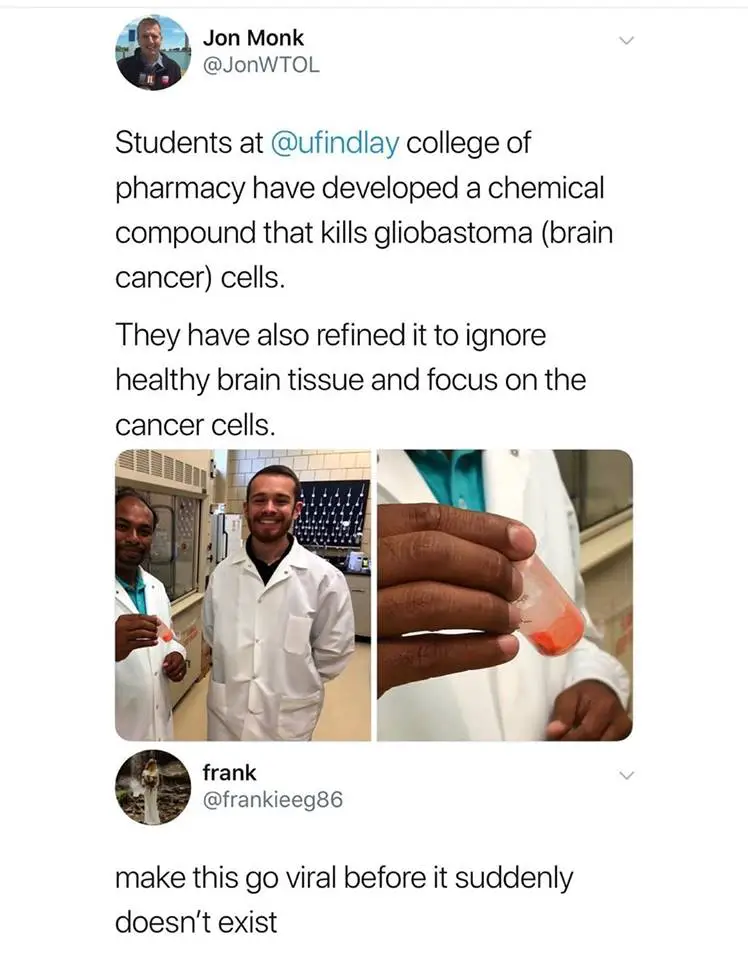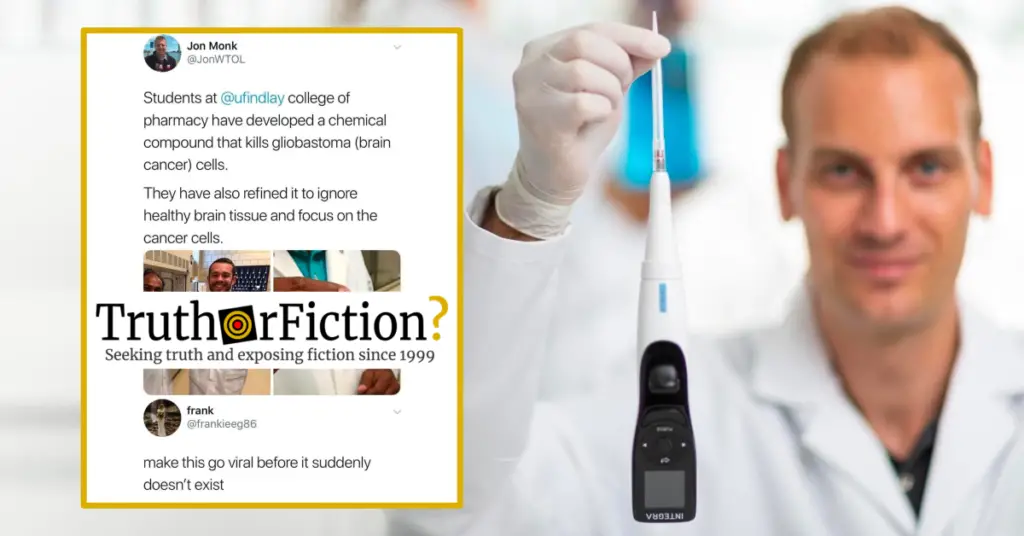On August 18 2019, Facebook page “Smooth AF” shared a screenshot of a tweet claiming that University of Findlay students had discovered a chemical compound that “kills glioblastoma cells”:

At the top of the image was an August 15 2019 tweet from WTOL reporter @JonWTOL:
It read in part:
Students at @ufindlay college of pharmacy have developed a chemical compound that kills gliobastoma (brain cancer) cells.
They have also refined it to ignore healthy brain tissue and focus on the cancer cells.
In the Facebook screenshot, the tweet and image were shown, minus a final sentence about a news segment. Underneath those, a second tweet read:
make this go viral before it suddenly doesn’t exist
One highly popular comment on the tweet was shared more than 20,000 times on Twitter. It claimed that cancer had already been “cured,” and that the government was suppressing that cure to preserve pharmaceutical industry profits — commentary similar to the second tweet shown in the Facebook post:
Basically the cure for cancer has basically been discovered but the government doesn’t want it coming out bc cancer gives the pharmaceutical industry so much money.
Comments on both the tweet and the Facebook post often espoused the view that a discovery like one described in the tweet would be seen as unfavorable to “big pharma.” A follow-up tweet referenced a lengthier companion video on the WTOL site.
In the video, the same reporter, Jon Monk, says that the difficulty in developing therapies for glioblastoma include identifying compounds that can target cancer cells while at the same time not harming healthy brain cells. Monk indicates a compound known as RK-15 is “a hundred times more selective” in targeting cancer cells over healthy brain cells, but the benchmark by which the efficacy of “one hundred times” was determined was not described.
During the two-minute segment, Monk says that the discovery is a breakthrough “that could very well lead to future treatment” for glioblastoma, not that the students developed an actual applicable therapy for the illness. He also says that glioblastoma has a ten percent five-year survival rate; a November 2017 item on Cancer.org provides the respective five-year survival rates for glioblastoma in three age groups as 19 percent, eight percent, and five percent.
A separate WNWO report published on August 15 2019 bears a headline stating that “University of Findlay researchers discover new drug to treat brain cancer.” But at the end of the article, it clarifies that the discovery may not yet be “a drug” as most readers understand it:
Researchers said the next step is to test on animals, then continue clinical testing on humans before it could get approved by the FDA.
They said it typically takes 10 to 15 years for a new drug to get from the lab to the patient. The team at the University of Findlay is on year two.
News about the RK-15 discovery also made it to Reddit’s r/futurology. A top comment on that thread addresses some points of confusion about the process of developing such findings into actual drugs:
Went and saw the video.
- It is mostly a piece about how undergraduates at this college of pharmacy got a chance to work on a project trying to identify potential agents to use to treat glioblastoma.
- Glioblastoma is a type of brain cancer that is hard to treat. Many brain cancers are hard to treat because of a natural defense system called the blood brain barrier that limits what is circulation in the blood from entering the fluid spaces around brain cells.
- Glioblastoma is also a very tough cancer regardless of the blood brain barrier.
- The video describes how the student worked on a project that found that some trial compound seemed to be better at killing cancer cells in a test environment (in vitro or literally in glass as in a test tube or plate) and they will now try to see if it will hold up in animal tissue studies.
- In other words, it is a LONG way from developing a chemical compound that could be used clinically in any practical way.
Experts made similar observations — even if the discovery is promising, it is still many years away from any practical application. Epidemiologist @GidMK responded with information about how novel and untested the discovery was based on the report’s limited detail:
According to the story this hasn’t even moved to rodent testing yet
>99% of treatments that make it to this stage fail before being used in people
— Health Nerd (@GidMK) August 18, 2019
Another medical expert noted that many therapies are in development, but are far from becoming viable options for cancer patients:
So wait, two pharm students…had access to large scale animal labs? Had teams recruiting patients for safety trials, and then enrolled hundreds of patients for clinical efficacy trials?
There are hundreds of cancer cures that work in petri dishes and even mice but not humans.
— John Jiao, MD ???? (@JohnJiao) August 18, 2019
However, those science-based observations were nearly drowned in a sea of conspiracy-oriented replies that the student researchers were “at risk” of being killed or silenced — comments that skimmed over the medical commentary noting that many similar treatments were already in development (and scores more would not progress to a trial stage):
that’s great and all but watch them die from “mysterious deaths” and the compound suddenly disappears
— ???????????????????????????????? ???????????????????????????????????? (@tattooheartafi) August 18, 2019
If they want to live , they need to hide. It’s so sad to say, but every scientist/person that finds a cure comes up missing or dead ????
— ɕأɑʀɑ ℘εƴƭℴ ɳ ♡ (@CiaraaaNicole) August 18, 2019
A number of local news affiliates reported on the pharmacy students’ discovery of RK-15, stating that it “very well may” lead to eventual glioblastoma therapies. Many readers and commenters appeared to infer the students had invented a drug ready for market, which was not the case. Separate comments suggested that the students were at risk of harm due to mysterious forces determined to suppress cancer cures, a common but baseless conspiracy theory predicated in part on confusion about the manner in which drugs are researched, developed, and readied for market — as well as incomplete reporting and headlines suggesting the discovery was a drug ready to be offered to to cancer patients at the time the reports appeared.
- Local pharmacy students develop cancer fighting compound
- Survival Rates for Selected Adult Brain and Spinal Cord Tumors
- University of Findlay researchers discover new drug to treat brain cancer
- Students at Findlay college of pharmacy have developed a chemical compound that kills glioblastoma (brain cancer) cells

